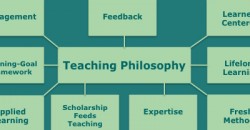Teaching Philosophy

I was astonished to discover that in the five years I had been away from teaching and had entered a PhD program, I continued to improve. I became a learner in a new realm through my PhD studies. As a learner at the PhD level, I was better prepared than I had been five years previously to guide my community of learners. The aggregate experience of my first years of teaching, my five-year hiatus and doctoral studies, and my current teaching have contributed the following tenets that comprise my teaching philosophy:
- Engagement, Interactivity, and Reflection: College students are adults who have access to a world of information far more vast than my generation ever imagined. Therefore, the most important priority of education is to engage them, interact with them, motivate them to interact with the material, and inspire them to learn. I also support the importance of student reflection on their learning.
- Feedback Loop: I believe in giving students comprehensive, detailed feedback, especially about their writing. I write detailed comments on their assignments. I encourage them to bring me their assignments for review – both before and after the assignment is handed in. At the same time, I learn from my students’ feedback.
- Communication and Personalized, Learner-Centered Attention: Communication is s significant element of my classes, so I encourage students to communicate with me and with each other. I learn my students’ names. I encourage them to take advantage of office hours and to seek help. I embrace the diversity of my students – their diverse backgrounds, ethnicities, learning styles, personalities, and more.
- Lifelong Learning: My goal is to stimulate student interest in continuing to learn for a lifetime about the topics I teach and to model that learning as a lifelong learner myself. I maintain warm relationships with students I’ve had throughout my teaching career, many of whom still come to me for advice.
- Commitment to Honing Andragogical Methods: Hand in hand with my dedication to lifelong learning is my desire to always consider new ways to approach teaching. I am always ready to experiment with innovative techniques to engage students in learning. I am especially interested in ways to use technology and computer-mediated communication in teaching and learning.
- Subject-Matter Expertise and Professional Development: A teacher should know his or her stuff. My five years as an entrepreneur, along with my PhD studies, have solidified my expertise, while my commitment to lifelong learning ensures that my knowledge won’t grow stale.
- Scholarship Feeds Teaching/Teaching Feeds Scholarship: When I needed material for teaching college students to write cover letters, I wrote a book to fill that need. I did the same when I needed material about networking and informational interviewing. The research I’ve done to date largely focuses on andragogical approaches. Such will not always be the case, but I have consistently maintained that my teaching feeds my writing, and my writing feeds my teaching.
- Applied Learning: As Phi Beta Kappa scholar, I value the rich liberal-arts tradition in which my academic roots are firmly planted. I also strongly support learning with real-world applicability. Comments from my students suggest that this real-world learning has helped them immensely as they ventured beyond academia.
- Framework of Learning Goals: Andragogy can be better organized and learning goals attained when they are built on a solid framework of accepted objectives, such as Bloom’s Taxonomy (in both the Cognitive and Affective domains), the learning goals of the school in which I am teaching, and current scholarship on 21st-century skills (such as Assess21). My first 6.5 years of teaching were in an AACSB_accredited business school, and I integrated my school’s AACSB standards in my teaching. The collective goals must then be synthesized because no one set of goals is sufficient for a complete educational experience.


